中医英语术语翻译重点
中医英语术语翻译重点教学文案
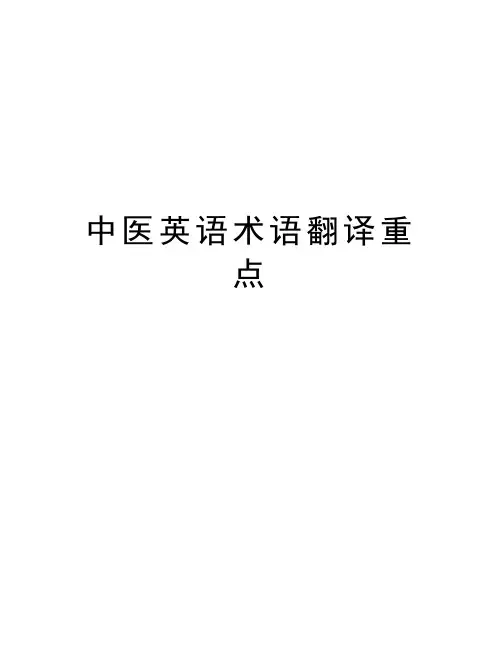
中医英语术语翻译重点中医英语术语翻译重点天人相应Correspondence of human body and natural environment辨证论治treatment based onsyndrome differentiation针灸acupuncture and moxibustion寒凉药物herbs cold and cool in nature滋阴降火nourishing yin and reducing fire整体观念concept of holism开窍(of the five zang-organs) open into生长化收藏sprout, grow, transform, ripen and store同病异治different therapeutic methods used to treat the same disease 异病同治same therapeutic method used to treating different diseases 从阴引阳drawing yang from yin阴平阳秘balance of yin and yang寒极生热extreme cold generating heat热极生寒 extreme heat gernerating cold病机总纲general rule of pathogenesis祛风散寒eliminating wind and dispersing cold实则泻之treating excess syndromes with reduction虚寒证deficiency cold syndrome实热症 excess heat syndrome潜阳熄风suppressing yang and eliminating wind补其不足 supplement insufficiency泻其有余 reduce excess五行学说the theory of five elements木曰曲直wood characterized by bending and straightening火曰炎上fire characterized by flaring up土爰稼穑earth characterized by sowing and reaping金曰从革metal characterized by clearing and changing水曰润下water characterized by moistening and descending母病及子illness of mother viscera affecting the child one子病及母illness of child viscera affecting the mother one相乘相侮over restriction and counter-restriction心火亢盛exuberant fire in the heart肾阳式微declination of kidney yang平肝和胃soothing the liver and harmonizing the stomach水火不济between water and fire奇恒之腑extraordinary fu-organs藏象学说the theory of visceral manifestation藏而不泻storage without discharge泻而不藏discharge without storage形体诸窍physical build and various orifices其华在面the luster manifesting upon the face满而不实 full but not to be solid实而不满solid but not to be full心主血脉heart governing blood and vessels肺司呼吸lung controlling breathing脾主运化spleen governing transportation and transformation肝主疏泄liver controlling conveyance and dispersion肾主藏精kidney governing storing essence面色无华lusterless complexion汗血同源sweat and blood sharing the same origin升降出入ascending, descending, going out and going in宣发肃降dispersion, purification and descent后天之本acquired base of life肝气逆上upward adverse flow of liver qi先天之精innate essence奇恒之腑extraordinary fu-organs孤俯isolated fu-organ腐熟水谷digest water and food七冲门the seven important portals胆主决断The gallbladder is responsible for making judgment泌别清浊separating the lucid from the turbid大肠主津The large intestine governs thin body fluid小肠主液The small intestine governs thick body fluid先天禀赋innateness温养腑脏warming and nourishing the viscera津血同源body fluid and blood sharing the same origin气为血帅,血为气母Qi commands the blood and the blood carries qi. 益气固脱nourishing qi to stop collapse奇经八脉eight extraordinary vessels十二经筋tendons of the twelve regular meridians舒经活络soothing meridians and activating collaterals刺络拔罐collateral pricking and cupping therapy腠理闭塞stagnation of interstitial space湿邪困脾pathogenic dampness obstructing the spleen外感六淫six excesses pathogenic factors饮食劳倦mproper diet and overstrain阳常有余,阴常不足Yang is usually excessive while yin is frequently deficient.四大经典Four GreatClassic:Huangdi s Canon of Medicine黄帝内经Classic of Difficulties难经Shennong s Classic of Materia Medica神农本草经Rreatise on Cold Damage and Miscellaneous Diseases伤寒杂病论四气four properties:cold,,hot,warm,cool五味five flavors:sour,bitter,sweet,pungent,salty(中药)七情seven conditions of ingredients in prescriptionsSingle effect,mutual reinforcement,mutual assistance,mutual restraint,mutual inhibition,mutual antagonism,mutual suppression寒凉派Liu Wansu-School of Cold and Cool攻下派Zhang Congzheng-School of Purgation补土派Li Gao-School of Reinforcing the Earth滋阴派Zhu Zhenheng-School of Nourishing Yin辛温中药herbs pungent in taste and warm in nature辛凉中药herbs pungent in taste and cool in narure向日为阳,背日为阴The side facing the sun belongs to yang and the reverse side to yin,血液常行的前提条件:心气充沛,血液充盈,脉道通利Normal circulation of blood:abundance of heart qi,sufficiency of blood,vessels are prerequisite.四气;元气primordial qi,宗气pectoral qi,营气nutrient qi,卫气defensive qi内生五邪;内风,内寒,内湿,内燥,内火Five internal excesses;internal wind.internal cold,internal dampness,inrenal dryness,internal fire内伤七情Internal injury due to sevenemotions;joy,anger,anxiety,thought,sorrow,fear,fright怒则气上,喜则气缓,悲则气消,恐则气下,惊则气乱。
中医词语对应的英文翻译

中医词语对应的英文翻译以下是一些中医常用词语及其对应的英文翻译,供参考。
1. 中药:Chinese medicine2. 针灸:Acupuncture3. 脉象:Pulse condition4. 望、闻、问、切:Observation, listening, inquiry, palpation5. 辨证论治:Syndrome differentiation and treatment6. 气滞血瘀:Qi stagnation and blood stasis7. 气血两虚:Qi and blood deficiency8. 风寒感冒:Wind-cold感冒9. 湿热证:Damp-heat syndrome10. 脾胃虚弱:Spleen-stomach weakness11. 肝火旺盛:Liver fire flaming12. 心火旺盛:Heart fire flaming13. 肺热咳嗽:Lung heat cough14. 脾虚泄泻:Spleen deficiency diarrhea15. 肾虚腰痛:Kidney deficiency waist pain16. 湿温病:Damp-heat disease17. 风湿病:Rheumatism18. 痛经:Menstrual pain19. 月经不调:Menstrual irregularity20. 更年期综合症:Menopause syndrome21. 肥胖症:Obesity22. 高血压病:Hypertension23. 糖尿病:Diabetes24. 失眠:Insomnia25. 抑郁症:Depression26. 焦虑症:Anxiety disorder27. 自闭症:Autism28. 强迫症:OCD (Obsessive-Compulsive Disorder)29. 多动症:ADHD (Attention Deficit Hyperactivity Disorder)30. 老年痴呆症:Alzheimer's disease31. 帕金森病:Parkinson's disease32. 癌症:Cancer33. 白血病:Leukemia34. 心脏病:Heart disease35. 肝病:Liver disease36. 肾病:Kidney disease37. 肺病:Lung disease38. 高脂血症:Hyperlipidemia39. 甲亢:Hyperthyroidism40. 甲减:Hypothyroidism41. 黄褐斑:Chloasma42. 白癜风:Vitiligo43. 牛皮癣:Psoriasis44. 带状疱疹:Shingles45. 水痘:Chickenpox46. 麻疹:Measles47. 风疹:Rubella (German measles)48. 痄腮:Mumps (耳下腺炎)49. 红眼病(急性结膜炎):Red eye (acute conjunctivitis)50. 中耳炎:Otitis media (middle ear infection)请注意,这些翻译可能并不完全准确或具体,因为中医是一个非常复杂和深奥的医学系统,其概念和术语往往难以用简单的英文词汇来表达,仅供参考。
中医英语翻译重点
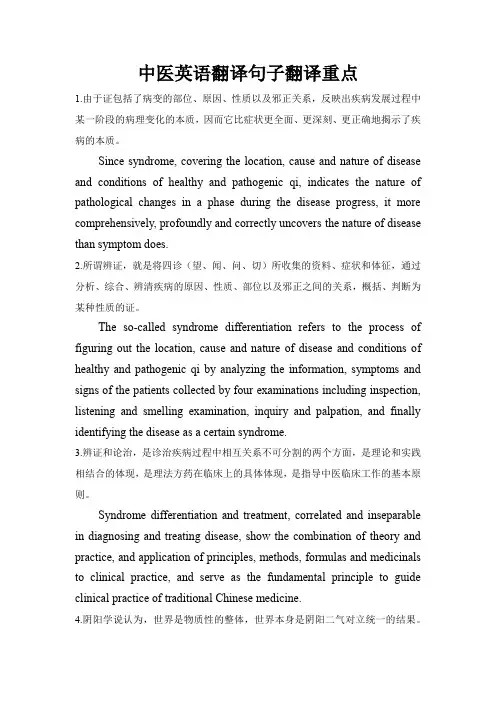
中医英语翻译句子翻译重点1.由于证包括了病变的部位、原因、性质以及邪正关系,反映出疾病发展过程中某一阶段的病理变化的本质,因而它比症状更全面、更深刻、更正确地揭示了疾病的本质。
Since syndrome, covering the location, cause and nature of disease and conditions of healthy and pathogenic qi, indicates the nature of pathological changes in a phase during the disease progress, it more comprehensively, profoundly and correctly uncovers the nature of disease than symptom does.2.所谓辨证,就是将四诊(望、闻、问、切)所收集的资料、症状和体征,通过分析、综合、辨清疾病的原因、性质、部位以及邪正之间的关系,概括、判断为某种性质的证。
The so-called syndrome differentiation refers to the process of figuring out the location, cause and nature of disease and conditions of healthy and pathogenic qi by analyzing the information, symptoms and signs of the patients collected by four examinations including inspection, listening and smelling examination, inquiry and palpation, and finally identifying the disease as a certain syndrome.3.辨证和论治,是诊治疾病过程中相互关系不可分割的两个方面,是理论和实践相结合的体现,是理法方药在临床上的具体体现,是指导中医临床工作的基本原则。
中医英文术语
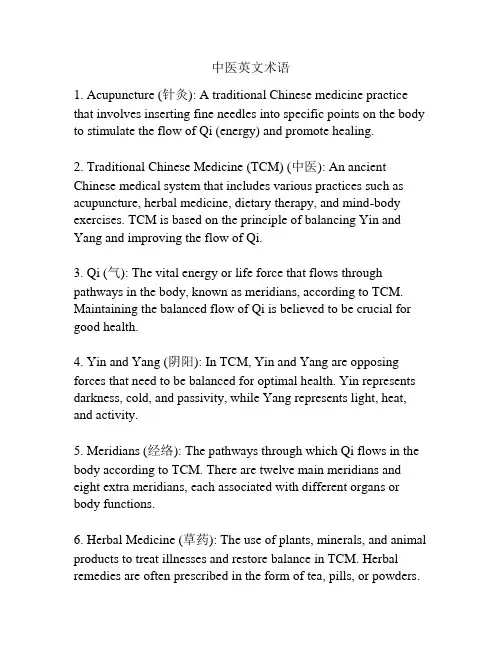
中医英文术语1. Acupuncture (针灸): A traditional Chinese medicine practice that involves inserting fine needles into specific points on the body to stimulate the flow of Qi (energy) and promote healing.2. Traditional Chinese Medicine (TCM) (中医): An ancient Chinese medical system that includes various practices such as acupuncture, herbal medicine, dietary therapy, and mind-body exercises. TCM is based on the principle of balancing Yin and Yang and improving the flow of Qi.3. Qi (气): The vital energy or life force that flows through pathways in the body, known as meridians, according to TCM. Maintaining the balanced flow of Qi is believed to be crucial for good health.4. Yin and Yang (阴阳): In TCM, Yin and Yang are opposing forces that need to be balanced for optimal health. Yin represents darkness, cold, and passivity, while Yang represents light, heat, and activity.5. Meridians (经络): The pathways through which Qi flows in the body according to TCM. There are twelve main meridians and eight extra meridians, each associated with different organs or body functions.6. Herbal Medicine (草药): The use of plants, minerals, and animal products to treat illnesses and restore balance in TCM. Herbal remedies are often prescribed in the form of tea, pills, or powders.7. Cupping (拔罐): A therapy in which glass or plastic cups are placed on the skin to create a vacuum, stimulating blood flow and relieving muscle tension. Cupping is often used for pain relief and promoting healing.8. Moxibustion (艾灸): A technique that involves burning dried mugwort herb (moxa) near the skin or on acupuncture points to warm and stimulate the flow of Qi. Moxibustion is commonly used to treat cold-related conditions.9. Tui Na (推拿): A form of Chinese therapeutic massage that involves various techniques such as kneading, pressing, and stretching to stimulate the flow of Qi and relieve pain or tension.10. Gua Sha (刮痧): A technique in which a blunt instrument, such as a special spoon or coin, is used to scrape the skin in order to promote blood circulation and alleviate pain or inflammation.11. Five Elements (五行): The concept in TCM that categorizes phenomena into five elements - Wood, Fire, Earth, Metal, and Water. Each element corresponds to certain organs, emotional characteristics, seasons, and other aspects of health.12. Pattern Differentiation (辨证论治): The TCM diagnostic method that involves analyzing a patient's symptoms and signs to determine the underlying pattern of disharmony in the body. Treatment is then tailored based on the specific pattern identified.13. Herbal Formulas (方剂): Specific combinations of herbs prescribed by TCM practitioners to address the individual pattern of disharmony. These formulas are often customized for each patient's unique needs.14. Dampness (湿): An imbalance in TCM characterized by excessive moisture or fluid accumulation in the body, which can cause symptoms such as bloating, fatigue, and heavy sensation.15. Heat (热): An excess of Yang energy in the body, leading to symptoms such as fever, thirst, inflammation, and restlessness. Heat can be caused by external factors or internal imbalances.。
中医的专业术语英文翻译(2)
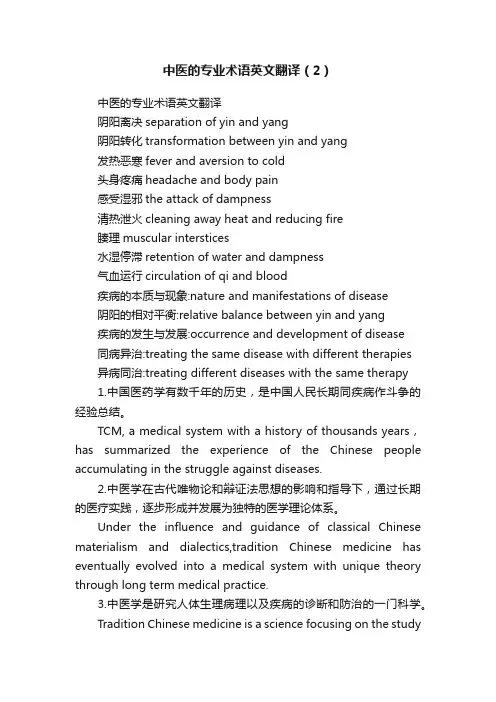
中医的专业术语英文翻译(2)中医的专业术语英文翻译阴阳离决separation of yin and yang阴阳转化transformation between yin and yang发热恶寒fever and aversion to cold头身疼痛headache and body pain感受湿邪the attack of dampness清热泄火cleaning away heat and reducing fire腠理muscular interstices水湿停滞retention of water and dampness气血运行circulation of qi and blood疾病的本质与现象:nature and manifestations of disease阴阳的相对平衡:relative balance between yin and yang疾病的发生与发展:occurrence and development of disease同病异治:treating the same disease with different therapies异病同治:treating different diseases with the same therapy1.中国医药学有数千年的历史,是中国人民长期同疾病作斗争的经验总结。
TCM, a medical system with a history of thousands years,has summarized the experience of the Chinese people accumulating in the struggle against diseases.2.中医学在古代唯物论和辩证法思想的影响和指导下,通过长期的医疗实践,逐步形成并发展为独特的医学理论体系。
Under the influence and guidance of classical Chinese materialism and dialectics,tradition Chinese medicine has eventually evolved into a medical system with unique theory through long term medical practice.3.中医学是研究人体生理病理以及疾病的诊断和防治的一门科学。
中医的专业术语英文翻译
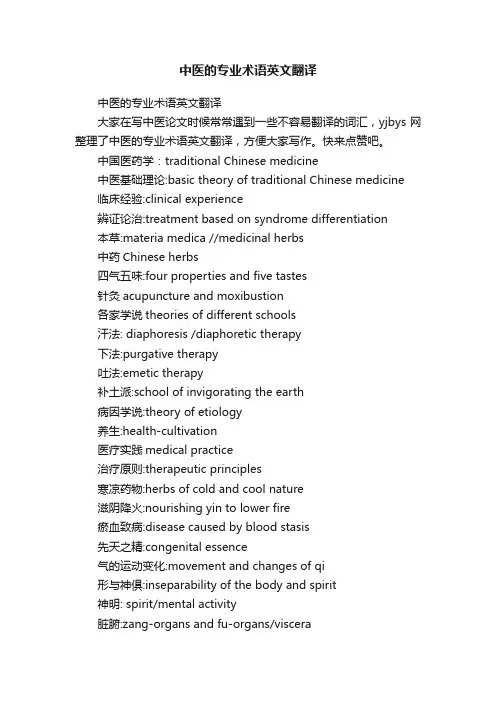
中医的专业术语英文翻译中医的专业术语英文翻译大家在写中医论文时候常常遇到一些不容易翻译的词汇,yjbys网整理了中医的专业术语英文翻译,方便大家写作。
快来点赞吧。
中国医药学:traditional Chinese medicine中医基础理论:basic theory of traditional Chinese medicine临床经验:clinical experience辨证论治:treatment based on syndrome differentiation本草:materia medica //medicinal herbs中药Chinese herbs四气五味:four properties and five tastes针灸acupuncture and moxibustion各家学说theories of different schools汗法: diaphoresis /diaphoretic therapy下法:purgative therapy吐法:emetic therapy补土派:school of invigorating the earth病因学说:theory of etiology养生:health-cultivation医疗实践medical practice治疗原则:therapeutic principles寒凉药物:herbs of cold and cool nature滋阴降火:nourishing yin to lower fire瘀血致病:disease caused by blood stasis先天之精:congenital essence气的运动变化:movement and changes of qi形与神俱:inseparability of the body and spirit神明: spirit/mental activity脏腑:zang-organs and fu-organs/viscera功能活动:functional activities形神统一:unity of the body and spirit阴阳失调:imbalance of yin and yang正邪相争:struggle between healthy qi and pathogenic factors 治未病prevention of disease调养 to cultivate health正气 healthy qi病邪 pathogenic factor疾病的防治 prevention and treatment of disease整体观念 concept of holism五脏five zang-organs六腑six fu-organs经络系统system of meridians and collaterals形神统一unity of the body and spirit有机整体organic wholeness表里关系exterior and interior relation开窍opening into生长化收藏five element function脉象pulse conditions正邪关系the states of pathogenic factors and healthy qi自然现象natural phenomena哲学概念philosophical concept对立统一unity and opposites相互消长mutual waning and waxing阴阳属性nature of yin and yang相互转化mutual transformation相互联系interrelation相互制约mutual restraint动态平衡dynamic balance阴平阳秘yin and yang in equilibrium阳消阴长 yang waning and yin waxing阴胜则阳病predominance of yin leading to disorder of yang 阳胜则热 predominance of yang generating heat寒极生热 extreme cold generating heat热极生寒extreme heat generating cold相反相成 opposite and supplementary to each other生理功能physiological functions病理变化pathological changes临床诊断clinical diagnosis有机整体organic wholeness/entirety正邪斗争struggle between healthy qi and pathogenic factors 绝对偏盛absolute predominance阳虚则寒yang deficiency leading to cold阳损及阴consumption of yang involving yin阴液不足insufficiency of yin-fluid病机pathogenesis五行学说theory of five elements运动变化motion and variation条达舒畅free development相生相克mutual generation and restriction生我我生to be generated and to generate克我我克to be restricted and to restrict生中有制restriction within generation克中有生generation within restriction木曰曲直Wood is characterized by growing freely and peripherally火曰炎上Fire is characterized by flaming up土曰稼穑Earth is characterized by cultivation and reaping金曰从革Metal is characterized by change水曰润下Water is characterized by moistening anddownward flowing方位配五行correspondence of the directions to the five elements相乘相侮over-restriction and reverse restriction土乘木The wood over-restrains the earth土虚木乘 Earth deficiency leading to over-restriction by wood 金虚木侮metal deficiency leading to counter-restriction by wood生克制化interrelationship between generation and restriction制则生化restriction ensuring generation传变transmission of disease母病及子disease of the mother-organ affecting the child-organ子病犯母disease of the child-organ affecting the mother-organ肝肾精血不足insufficiency of kidney and liver essence and blood肝阳上亢hyperactivity of liver yang藏象学说 theory of visceral manifestations五脏六腑 five zang-organs and six fu-organs奇恒之府 extraordinary fu-organs水谷精微 cereal nutrients传化水谷 transmissions and transformation of food贮藏精气 storage of essence表里关系 interior and exterior relationship治疗效应 curative effect临床实践 clinical practice藏而不泻 storage without excretion心肝血虚deficiency of heart and liver blood心肝火旺exuberance of heart and liver fire心火亢盛exuberance of heart fire滋肾养肝nourishing the kidney and liver肝阴不足insufficiency of the liver yin温肾健脾warming the kidney and strengthening the spleen 肾阳式微declination of kidney yang脾阳不振inactivation of spleen yang肝旺脾虚hyperactivity of the liver and weakness of the spleen 脾胃虚弱weakness of the spleen and stomach平肝和胃soothing the liver and harmonizing the stomach水湿停聚retention of water-dampness肾阴不足insufficiency of kidney yin心肾不交disharmony between the heart and kidney水火不济discordance between water and fire阴阳俱损simultaneous consumption of yin and yang阴阳两虚simultaneous deficiency of both yin and yang损其有余reducing excess补其不足supplementing insufficiency阴中求阳obtaining yang from yin虚寒证deficiency-cold syndrome扶阳益火strengthening yang to increasing fire祛风散寒eliminating wind to dispersing cold消导积滞promoting digestion and removing food retention 潜阳息风suppressing yang to quench wind阴阳的互根互用interdependence of yin and yang相互依存interdependence。
中医常用术语英文翻译
中医常用术语英文翻译[学科]中医①traditional Chinese medicine②traditional Chinesephysician ①中医学的简称。
②本学科专业职业队伍。
中药Chinesemateria medica 在中医理论指导下应用的药物。
包括中药材、中药饮片和中成药等。
中医学 traditionalChinese medicine 以中医药理论与实践经验为主体,研究人类生命活动中健康与疾病转化规律及其预防、诊断、治疗、康复和保健的综合性科学。
中药学Chinese materiamedica 中药学科的统称。
研究中药基本理论和各种药材饮片、中成药的来源、采制、性能、功效、临床应用等知识的学科。
中医药 traditionalChinese medicine and pharmacology本草:Materia medica中药:Chinese materiamedica,Chinese medicinals(包括植物药、动物药、矿物药等)中草药:Chinese HerbalMedicine,Chinese medicinal herbs中药学:Chinese pharmaceutics药材:Medicinalsubstance(material)中西医结合 integration of traditional and western medicine 中医基础理论 basictheory of traditional Chinese medicine 中医诊断学 diagnostics of traditional Chinese medicine 方剂学 prescriptions of Chinese materia medica,Traditional Chinese Medical Formulae/ prescriptions中医内科学 internal medicine of traditional Chinese medicine[阴阳]The Theory of Yinand Yang阴阳对立:Opposition of yin andyang阴阳制约:Restriction of/between yin and yang阴阳互根:Interdependence ofyin and yang阴阳消长:Waxing and waning ofyin and yang阴阳转化:Inter-transformationof yin and yang[五行学说]The Theory of FiveElements五行:water,fire,wood,metal,soil生:promote, generate,engender克: act, restrict,restrain乘:overact,over-restrict, over-restrain, subjugate, overwhelm侮:counteract,counter-restrict, counter-restrain, rebel[整体观念] concept of organicwholeness辩证法 dialectics生长化收藏 sprouting, growth,transformation,ripening,storage内外环境统一性 the unity betweenthe internal and external environments机体自身整体性 the integrity of thebody itself古代唯物论和辩证法 classic Chinesematerialism and dialectics 矛盾统一the contradictoryunity互相联系、相互影响related to each otherand influence each other标本 Biao (secondaryaspect) and Ben (primary aspect)本质与现象nature and phenomena矛盾的普遍性和特殊性universality andspeciality of contradictions寒者热之Cold disease shouldbe treated by warm therapy热者寒之warm disease shouldbe treated by cold therapy虚者补之deficiency syndromeshould be treated by tonifyingtherapy实者泻之excess syndromeshould be treated by purgation therapy治病必求其本 Treatment ofdiseases must concentrate on the root cause同病异治treatment ofthe same disease with different therapeutic methods异病同治treatment ofdifferent diseases with the same therapeutic method[精气神]清阳为天 The lucid Yangascends to form the heaven浊阴为地 The turbid Yindescends to constitute the earth气化 Qitransformation升降出入 ascending,descending, going out, coming in出入废则神机化灭,升降息则气立孤危。
中医药常用名词术语英译
中医药常用名词术语英译1. 嘿,你知道“阴阳”在中医药里怎么英译不?“Yin - Yang”呀。
就好比白天和黑夜,一个是阳,一个是阴,它们相互对立又相互依存呢。
比如说,一个人身体太“阳”了,可能就容易上火,就像夏天太阳太猛,大地都干涸了。
2. 咱来聊聊“气”这个词的英译,“Qi”。
这“气”啊,就像身体里的小发动机。
我有个朋友,老是没精打采的,中医就说他“气”不足。
这“气”在身体里到处跑,推动着身体各个机能运转呢。
3. “经络”的英译是“Meridian”。
这经络就像身体里的高速公路网哦。
我上次去看中医,医生说经络不通会导致很多毛病。
就像高速公路堵了,车就没法顺畅地跑,身体里的气血也一样。
4. “穴位”的英语是“Acupoint”。
穴位就像身体上的一个个小开关。
有次我头疼,中医在我头上的一个穴位按了几下,哎呀,就像打开了止痛的开关一样,立马感觉好多了。
5. “中药”的英译是“Chinese materia medica”。
这中药可神奇啦,就像大自然赐给我们的医药宝藏。
我奶奶生病就爱喝中药,那些草药熬出来的汤,感觉就像把大自然的力量都喝进肚子里了。
6. 你了解“方剂”的英译吗?是“Prescription”。
方剂就像是一个医药团队。
比如说一个治疗感冒的方剂,里面有好几味中药,就像团队里不同的成员,各自发挥着作用,一起把感冒这个“敌人”打败。
7. “炮制”的英语是“Processing”。
这炮制就像给中药做一场精心的改造。
我见过中药师傅炮制药材,把原本普普通通的药材,经过各种工序,就像把一个灰姑娘变成公主一样,药效都变得更厉害了。
8. “辨证论治”的英译是“Treatment based on syndrome differentiation”。
这就像医生当侦探呢。
我去看中医,医生又是看舌头,又是把脉,然后判断我的“证”,再根据这个来治疗。
就像侦探根据线索破案一样精准。
9. “四气五味”的英语是“Four natures and five flavors”。
常见中医术语英文翻译及中文释义
常见中医术语英文翻译及中文释义-CAL-FENGHAI.-(YICAI)-Company One1郑州市管城中医院肿瘤科整理常见中医术语英文翻译及中文释义常见中医术语英文翻译及中文释义中医术语的中英文参考对照治则 principle of treatment 在对临床的具体立法、处方、用药等具有普遍的指导意义,因而在治疗疾病时必须遵循的基本原则。
治病求本 treatment aiming at its pathogenesis 针对产生疾病的根本原因进行治疗的原则。
急则治标 symptomatic treatment in acute condition 与缓则治本相对而言,在大出血、暴泻、剧痛等标症甚急的情况,及时救治标病。
缓则治本 radical treatment in chronic case 与急则治标相对而言,针对病势缓和、病情缓慢的情况,从本病的病机出发,采取调理、补益为主的治疗原则。
标本兼治 treating both manifestation and root cause of disease 针对病证出现的标本并重的情况,采用治标与治本相结合的治疗原则。
治未病 preventive treatment of disease 采取一定的措施防止疾病产生和发展的治疗原则,包括未病先防和既病防变两个方面。
同病异治 treating same disease with different methods 表现相同的病证,可因人、因时、因地的不同,或由于病情的发展、病机的变化、病型的各异、正邪消长等差异,采取不同治法的治疗原则。
异病同治 treating different diseases with same method 表现不同的病证,由于发病机理相同,采取相同治法的治疗原则。
因时制宜 treatment in accordance with seasonal conditions 考虑到时令气候寒热燥湿的不同而选择适宜的治法、方药的治疗原则。
中医英语术语翻译重点
中医英语术语翻译重点天人相应Correspondence of human body and natural environment辨证论治treatment based onsyndrome differentiation针灸acupuncture and moxibustion寒凉药物herbs cold and cool in nature滋阴降火nourishing yin and reducing fire整体观念concept of holism开窍(of the five zang-organs) open into生长化收藏sprout, grow, transform, ripen and store同病异治different therapeutic methods used to treat the same disease 异病同治same therapeutic method used to treating different diseases 从阴引阳drawing yang from yin阴平阳秘balance of yin and yang寒极生热extreme cold generating heat热极生寒 extreme heat gernerating cold病机总纲general rule of pathogenesis祛风散寒eliminating wind and dispersing cold实则泻之treating excess syndromes with reduction虚寒证deficiency cold syndrome实热症 excess heat syndrome潜阳熄风suppressing yang and eliminating wind补其不足 supplement insufficiency泻其有余 reduce excess五行学说the theory of five elements木曰曲直wood characterized by bending and straightening火曰炎上fire characterized by flaring up土爰稼穑earth characterized by sowing and reaping金曰从革metal characterized by clearing and changing水曰润下water characterized by moistening and descending母病及子illness of mother viscera affecting the child one子病及母illness of child viscera affecting the mother one相乘相侮over restriction and counter-restriction心火亢盛exuberant fire in the heart肾阳式微declination of kidney yang平肝和胃soothing the liver and harmonizing the stomach水火不济between water and fire奇恒之腑extraordinary fu-organs藏象学说the theory of visceral manifestation藏而不泻storage without discharge泻而不藏discharge without storage形体诸窍physical build and various orifices其华在面the luster manifesting upon the face满而不实 full but not to be solid实而不满solid but not to be full心主血脉heart governing blood and vessels肺司呼吸lung controlling breathing脾主运化spleen governing transportation and transformation肝主疏泄liver controlling conveyance and dispersion肾主藏精kidney governing storing essence面色无华lusterless complexion汗血同源sweat and blood sharing the same origin升降出入ascending, descending, going out and going in宣发肃降dispersion, purification and descent后天之本acquired base of life肝气逆上upward adverse flow of liver qi先天之精innate essence奇恒之腑extraordinary fu-organs孤俯isolated fu-organ腐熟水谷digest water and food七冲门the seven important portals胆主决断The gallbladder is responsible for making judgment泌别清浊separating the lucid from the turbid大肠主津The large intestine governs thin body fluid小肠主液The small intestine governs thick body fluid先天禀赋innateness温养腑脏warming and nourishing the viscera津血同源body fluid and blood sharing the same origin气为血帅,血为气母Qi commands the blood and the blood carries qi.益气固脱nourishing qi to stop collapse奇经八脉eight extraordinary vessels十二经筋tendons of the twelve regular meridians舒经活络soothing meridians and activating collaterals刺络拔罐collateral pricking and cupping therapy腠理闭塞stagnation of interstitial space湿邪困脾pathogenic dampness obstructing the spleen外感六淫six excesses pathogenic factors饮食劳倦mproper diet and overstrain阳常有余,阴常不足Yang is usually excessive while yin is frequently deficient. 四大经典Four GreatClassic:Huangdi s Canon of Medicine黄帝内经Classic of Difficulties难经Shennong s Classic of Materia Medica神农本草经Rreatise on Cold Damage and Miscellaneous Diseases伤寒杂病论四气four properties:cold,,hot,warm,cool五味five flavors:sour,bitter,sweet,pungent,salty(中药)七情seven conditions of ingredients in prescriptionsSingle effect,mutual reinforcement,mutual assistance,mutual restraint,mutual inhibition,mutual antagonism,mutual suppression寒凉派Liu Wansu-School of Cold and Cool攻下派Zhang Congzheng-School of Purgation补土派Li Gao-School of Reinforcing the Earth滋阴派Zhu Zhenheng-School of Nourishing Yin辛温中药herbs pungent in taste and warm in nature辛凉中药herbs pungent in taste and cool in narure向日为阳,背日为阴The side facing the sun belongs to yang and the reverse side to yin,血液常行的前提条件:心气充沛,血液充盈,脉道通利Normal circulation of blood:abundance of heart qi,sufficiency of blood,vessels are prerequisite.四气;元气primordial qi,宗气pectoral qi,营气nutrient qi,卫气defensive qi 内生五邪;内风,内寒,内湿,内燥,内火Five internal excesses;internal wind.internal cold,internal dampness,inrenal dryness,internal fire内伤七情Internal injury due to sevenemotions;joy,anger,anxiety,thought,sorrow,fear,fright怒则气上,喜则气缓,悲则气消,恐则气下,惊则气乱。
- 1、下载文档前请自行甄别文档内容的完整性,平台不提供额外的编辑、内容补充、找答案等附加服务。
- 2、"仅部分预览"的文档,不可在线预览部分如存在完整性等问题,可反馈申请退款(可完整预览的文档不适用该条件!)。
- 3、如文档侵犯您的权益,请联系客服反馈,我们会尽快为您处理(人工客服工作时间:9:00-18:30)。
中医英语术语翻译重点Last revision on 21 December 2020中医英语术语翻译重点天人相应Correspondence of human body and natural environment辨证论治treatment based onsyndrome differentiation针灸acupuncture and moxibustion寒凉药物herbs cold and cool in nature滋阴降火nourishing yin and reducing fire整体观念concept of holism开窍(of the five zang-organs) open into生长化收藏sprout, grow, transform, ripen and store同病异治different therapeutic methods used to treat the same disease异病同治same therapeutic method used to treating different diseases从阴引阳drawing yang from yin阴平阳秘balance of yin and yang寒极生热extreme cold generating heat热极生寒 extreme heat gernerating cold病机总纲general rule of pathogenesis祛风散寒eliminating wind and dispersing cold实则泻之treating excess syndromes with reduction虚寒证deficiency cold syndrome实热症 excess heat syndrome潜阳熄风suppressing yang and eliminating wind补其不足 supplement insufficiency泻其有余 reduce excess五行学说the theory of five elements木曰曲直wood characterized by bending and straightening火曰炎上fire characterized by flaring up土爰稼穑earth characterized by sowing and reaping金曰从革metal characterized by clearing and changing水曰润下water characterized by moistening and descending母病及子illness of mother viscera affecting the child one子病及母illness of child viscera affecting the mother one相乘相侮over restriction and counter-restriction心火亢盛exuberant fire in the heart肾阳式 of kidney yang平肝和胃soothing the liver and harmonizing the stomach水火不济between water and fire奇恒之腑extraordinary fu-organs藏象学说the theory of visceral manifestation藏而不泻storage without discharge泻而不藏discharge without storage形体诸窍physical build and various orifices其华在面the luster manifesting upon the face满而不实 full but not to be solid实而不满solid but not to be full心主血脉heart governing blood and vessels肺司呼吸lung controlling breathing脾主运化spleen governing transportation and transformation肝主疏泄liver controlling conveyance and dispersion肾主藏精kidney governing storing essence面色无华lusterless complexion汗血同源sweat and blood sharing the same origin升降出入ascending, descending, going out and going in宣发肃降dispersion, purification and descent后天之本acquired base of life肝气逆上upward adverse flow of liver qi先天之精innate essence奇恒之腑extraordinary fu-organs孤俯isolated fu-organ腐熟水谷digest water and food七冲门the seven important portals胆主决断The gallbladder is responsible for making judgment泌别清浊separating the lucid from the turbid大肠主津The large intestine governs thin body fluid小肠主液The small intestine governs thick body fluid先天禀赋innateness温养腑脏warming and nourishing the viscera津血同源body fluid and blood sharing the same origin气为血帅,血为气母Qi commands the blood and the blood carries qi. 益气固脱nourishing qi to stop collapse奇经八脉eight extraordinary vessels十二经筋tendons of the twelve regular meridians舒经活络soothing meridians and activating collaterals刺络拔罐collateral pricking and cupping therapy腠理闭塞stagnation of interstitial space湿邪困脾pathogenic dampness obstructing the spleen外感六淫six excesses pathogenic factors饮食劳倦mproper diet and overstrain阳常有余,阴常不足Yang is usually excessive while yin is frequently deficient.四大经典Four GreatClassic:Huangdi s Canon of Medicine黄帝内经Classic of Difficulties难经Shennong s Classic of Materia Medica神农本草经Rreatise on Cold Damage and Miscellaneous Diseases伤寒杂病论四气four properties:cold,,hot,warm,cool五味five flavors:sour,bitter,sweet,pungent,salty(中药)七情seven conditions of ingredients in prescriptionsSingle effect,mutual reinforcement,mutual assistance,mutual restraint,mutual inhibition,mutual antagonism,mutual suppression寒凉派Liu Wansu-School of Cold and Cool攻下派Zhang Congzheng-School of Purgation补土派Li Gao-School of Reinforcing the Earth滋阴派Zhu Zhenheng-School of Nourishing Yin辛温中药herbs pungent in taste and warm in nature辛凉中药herbs pungent in taste and cool in narure向日为阳,背日为阴The side facing the sun belongs to yang and the reverse side to yin,血液常行的前提条件:心气充沛,血液充盈,脉道通利Normal circulation of blood:abundance of heart qi,sufficiency ofblood,vessels are prerequisite.四气;元气primordial qi,宗气pectoral qi,营气nutrient qi,卫气defensiveqi内生五邪;内风,内寒,内湿,内燥,内火Five internal excesses;internal cold,internal dampness,inrenaldryness,internal fire内伤七情Internal injury due to sevenemotions;joy,anger,anxiety,thought,sorrow,fear,fright怒则气上,喜则气缓,悲则气消,恐则气下,惊则气乱。
思则气结;excessive anger drives qi to flow upward,excessive joy makes qisluggish,excessive sorrow consumes qi,excessive fear drives qi to flow downward,excessive fright disorders qi,excessive thought stagnates qi,六淫:风寒暑湿燥火wind,cold,summerheat,dampness,dryness,fire阴阳关系:oppose each other,depend on each other,wane and wax between each other,transform between each other.五行特征:generation,restriction,subjugation,counter-restriction.气的功能:promoting,warming,defending,consolidating,transforming气血关系:qi generates blood,qi propels blood,qi commands blood to circulate inside vessels to avoid bleeding,blood generates qi,blood carries qi.气与体液的关系:qi generates body fluid,qi promotes the flow of bodyfluid,qi controls body fluid,body fluid carries qi,body fluid generates qi.气冲门分类:飞门flying portal(唇lips)户门house portal(齿teeth)吸门inhaling portal(会厌epiglottis)贲门cardia(胃上口upper oppening of the stomach)幽门pylorus(胃下口lower opening of the stomach)阑门railingportal(小肠下口与大肠上口连接处conjunction of the large intestine and small intestine)魄门corporeal soul portal(肛门anus)精气为满,水谷为实。
